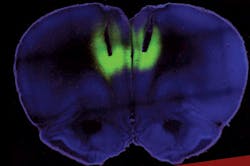Strategic use of laser light can turn addictive behavior on and off in rats, according to research conducted at the National Institutes of Health (NIH) and the University of California San Francisco (UCSF).1 The study reveals that the prefrontal cortex (PFC) plays a critical role in cocaine addiction, and it suggests a new therapy that could be tested immediately in humans.
Using optogenetics and directing laser light to the prelimbic region of the PFC, the scientists were able to turn non-addicted rats into compulsive cocaine seekers, and then switch off the compulsive behavior, said Antonello Bonci, MD, scientific director of the intramural research program at the NIH's National Institute of Drug Abuse (NIDA), where the work was done.
What makes the new work so promising is that the animal model mimics the compulsive behavior seen in human cocaine addiction: The animals, like human addicts, are more likely to make bad decisions and take cocaine even when they are conditioned to expect self-harm associated with it.
Billy Chen of NIDA, the lead author of the study, worked with colleagues to apply optogenetics: Using genetic engineering, they inserted light-sensitive proteins called rhodopsins into neurons in the rat's PFC. Activating this region with a laser tuned to the rhodopsins turned the nerve cells on and off.
Bonci notes that transcranial magnetic stimulation (TMS), which applies an external electromagnetic field to the brain, induces a similar activation of the prelimbic cortex in humans. Importantly, human therapy would not involve lasers. Clinical trials are due to begin soon at NIH, in which TMS will be used to treat people addicted to cocaine, to see if such treatments can help them avoid the drug.
1. B. T. Chen et al., Nature, 496, 359–362 (2013).

